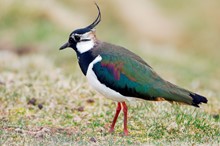14 February, 2018
Scotland’s woodland and farmland birds increase, as upland birds decline
Scotland’s woodland and farmland bird numbers have increased over the past two decades, but during this time, upland birds have faced decline. This is according to a Scottish Natural Heritage (SNH) report published today, The Official Statistic for Terrestrial Breeding Birds.
The latest results reveal varied trends for Scotland’s terrestrial breeding birds, with woodland birds increasing by 67% between 1994 and 2016, farmland birds increasing by 13%, but upland birds decreasing by 16%.
Woodland specialists, such as great-spotted woodpecker and chiffchaff, have shown the largest increases. Great-spotted woodpeckers have expanded across Europe, possibly as a result of increased forests and woodlands becoming more connected.
For farmland species, goldfinches have continued to increase and are now a common sight in most gardens. Whitethroat, a small migratory warbler, has also bounced back from their historical lows associated with droughts in their Sahelian overwintering grounds in Africa.
Upland birds are the most concerning group, with declines for 10 of the 17 species. Among the largest declines are breeding waders, including curlew, golden plover and lapwing. Major work is underway to help tackle these declines, including extensive peatland restoration and the Working for Waders project.
Simon Foster, SNH’s trends analyst, said:
“It’s wonderful to see that woodland and farmland birds are not only holding their own in Scotland, but that many are thriving. However, with some upland birds struggling, there are a lot of people and projects working hard to improve conditions for waders – some of which have seen worrying declines. We and many of our partners are hoping to see these birds fare better in the coming years.”
None of this would be possible without the enormous efforts of volunteers. The data for the report is largely collected by volunteers through the British Trust for Ornithology (BTO)/Joint Nature Conservation Committee (JNCC)/Royal Society for the Protection of Birds (RSPB) Breeding Bird Survey. For anyone interested in taking part, BTO are always looking for new helpers. For more information, see www.bto.org/volunteer-surveys.
Dr Chris Wernham, Head of BTO Scotland, added: "The Scottish uplands cover a vast area and are a key part of the country's landscape. Monitoring our upland bird populations presents a unique set of challenges – these are remote, often inaccessible areas, many miles from human population centres. It is thanks to the effort and dedication of intrepid volunteers that we are able to produce this report, which highlights worrying declines among a suite of upland bird species, contrasting with increases in many woodland birds. Through initiatives within the Breeding Bird Survey such as 'Upland Rovers' we hope to see continued improvements in coverage, enabling greater precision in our estimates of change, and in time allowing us to report trends for a greater number of species. For more on the Upland Rovers, see https://www.bto.org/volunteer-surveys/bbs/taking-part/upland-rovers"
SNH is working on strengthening bird populations and biodiversity throughout Scotland. The Scottish Biodiversity Strategy Route Map was published by Scottish Government in June 2015. It sets out the big steps needed to implement the Scottish Biodiversity Strategy 2020 Challenge, including restoring ecosystems, conserving wildlife, and sustainably managing land, freshwater and the marine environment. The SBS 2020 Challenge is Scotland’s response to the Aichi Targets set by the United Nations Convention on Biological Diversity calling for a step change in efforts to halt the loss of biodiversity and restore essential services that a healthy natural environment provides.
ENDS
MEDIA QUERIES - for more information, contact SNH media & PR officer, Vicki Mowat on vicki.mowat@snh.gov.uk or 0131 316 2659 (Tues-Thurs) or the SNH main press office in Inverness on 01463 725 022. PICTURES: Credit Lorne Gill/SNH.
Contact information
- Name
- SNH Media
- snhmedia@snh.gov.uk
Notes to editors
For the full report, see https://www.nature.scot/information-library-data-and-research/official-statistics/official-statistics-terrestrial-breeding-birds
The BBS is run by the British Trust for Ornithology (BTO), and jointly funded by the BTO, the Joint Nature Conservation Committee (JNCC, the statutory adviser to Government on UK and international nature conservation, on behalf of Natural Resources Wales, the Department of Agriculture, Environment and Rural Affairs, Northern Ireland, Natural England and Scottish Natural Heritage) and the Royal Society for the Protection of Birds (RSPB).
Scottish Natural Heritage is the government’s adviser on all aspects of nature and landscape across Scotland. Our role is to help everyone understand, value and enjoy Scotland’s nature now and in the future. For more information, visit our website at www.snh.gov.uk . SNH media is also now on Twitter at www.twitter.com/nature_scot
NatureScot is Scotland's nature agency. We work to enhance our natural environment in Scotland and inspire everyone to care more about it. Our priority is a nature-rich future for Scotland and an effective response to the climate emergency. For more information, visit our website at www.nature.scot or follow us on X at https://x.com/NatureScot
’S e NatureScot buidheann nàdair na h-Alba. Bidh sinn a’ neartachadh àrainneachd na h-Alba agus a’ brosnachadh dhaoine gu barrachd suim a chur ann an nàdar. Tha e mar phrìomhachas againn gum bi nàdar na h-Alba beairteach agus gun dèilig sinn gu h-èifeachdach le èiginn na gnàth-shìde. Tha an tuilleadh fiosrachaidh aig www.nature.scot no air X aig https://x.com/NatureScot


